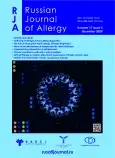Pharmacological profile of antihistamines: focus on unwanted drug interactions
- Authors: Dukhanin A.S.1
-
Affiliations:
- Pirogov Russian National Research Medical University
- Issue: Vol 17, No 4 (2020)
- Pages: 46-56
- Section: Lections
- URL: https://bakhtiniada.ru/raj/article/view/121573
- DOI: https://doi.org/10.36691/RJA1407
- ID: 121573
Cite item
Full Text
Abstract
Differences between individual antihistamines are determined by such pharmacokinetic properties as the rate and completeness of absorption, half-life, the participation of hepatic and renal mechanisms of elimination from the body. Pharmacodynamic features of the antihistamine include selectivity and affinity for histamine H1-receptors and the presence of central effects. The mechanisms of the development of unwanted drug interactions with second-generation antihistamines are analyzed in detail. Three levels of interaction have been identified: 1) hepatic enzymes of the P450 system; 2) membrane carriers of organic anions (OATP) – transport proteins on the sinusoidal membrane of hepatocytes and the luminal membrane of the epithelium of the proximal nephron tubule; 3) P-glycoprotein (Pgp, ABCB1-protein) of epithelial cells of the small intestine – the area of absorption of oral forms of antihistamines, the epithelium of the proximal tubule and the BBB (blood-brain barrier). The emphasis is made on the description of the dependence of the pharmacological profile of antihistamines on its chemical structure. The “elasticity” of the bilastine molecule, the ability to induce a change in conformation underlies the high complementarity of bilastine to the recognition site of the H1-receptor which is a high affinity. Experimental evaluation confirms this conclusion: the dissociation constant (Dс) of the bilastin-receptor complex is in the nM concentration range. The bilastine molecule, as a representative of antihistamines with zwitterionic properties, carries both a positive and a negative charge at a physiological pH, making it difficult for its penetration into the brain. The peculiarities of the chemical nature of the bilastine molecule are reflected in the specific pharmacological profile of AGP. In vitro studies have shown a high specific affinity of bilastine for H1-receptors with a very low affinity for other histamine receptors (H2, H3, H4), serotonin, bradykinin, muscarinic and adrenergic receptors). According to this indicator, bilastine is 3 times higher than cetirizine and 5 times higher than fexofenadine. Bilastine is practically not metabolized in the body and is excreted mainly unchanged, and also does not have a cardiotoxic effect. Bilastine is well tolerated; as a therapeutic dose it has a less pronounced sedative potential compared to other second-generation antihistamines.
Full Text
##article.viewOnOriginalSite##About the authors
Alexander S. Dukhanin
Pirogov Russian National Research Medical University
Author for correspondence.
Email: das03@rambler.ru
ORCID iD: 0000-0003-2433-7727
Professor at the Department of Molecular Pharmacology and Radiobiology, MD, PhD, Professor
Russian Federation, MoscowReferences
- Wang XY, Lim-Jurado M, Prepageran N, et al. Treatment of allergic rhinitis and urticaria: a review of the newest antihistamine drug bilastine. Ther Clin Risk Manag. 2016;12:585–597. doi: 10.2147/TCRM.S105189
- Jáuregui I, Ramaekers JG, Yanai K, et al. Bilastine: a new antihistamine with an optimal benefit-to-risk ratio for safety during driving. Expert Opin Drug Saf. 2016;15(1):89–98.doi: 10.1517/14740338.2016.1112786
- Wolthers OD. Bilastine: a new nonsedating oral H1-antihistamine for treatment of allergic rhinoconjunctivitis and urticaria. Biomed Res Int. 2013;2013:626837. doi: 10.1155/2013/626837
- Hu Y, Sieck DE, Hsu WH. Why are second-generation H1-antihistamines minimally sedating? Eur J Pharmacol. 2015;765:100–106. doi: 10.1016/j.ejphar.2015.08.016
- Kuna P, Bachert C, Nowacki Z, et al. Efficacy and safety of bilastine 20 mg compared with cetirizine 10 mg and placebo for the symptomatic treatment of seasonal allergic rhinitis: a randomized, double-blind, parallel-group study. Clin Exp Allergy. 2009;39(9):1338–1347.doi: 10.1111/j.1365-2222.2009.03257.x
- Kawauchi H, Yanai K, Wang DY, et al. Antihistamines for allergic rhinitis treatment from the viewpoint of nonsedative properties. Int J Mol Sci. 2019;20(1):213.doi: 10.3390/ijms20010213
- Paśko P, Rodacki T, Domagała-Rodacka R, et al. Second generation H1-antihistamines interaction with food and alcohol – a systematic review. Biomed Pharmacother. 2017;93:27–39.doi: 10.1016/j.biopha.2017.06.008
- Tiligada E, Ennis M. Histamine pharmacology: from Sir Henry Dale to the 21st century. Br J Pharmacol. 2020;177(3):469–489. doi: 10.1111/bph.14524
Supplementary files

















